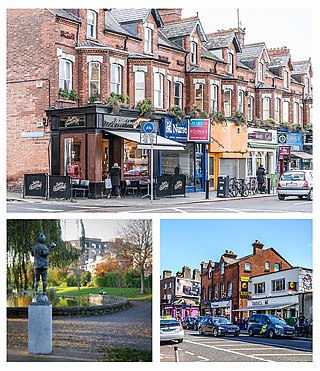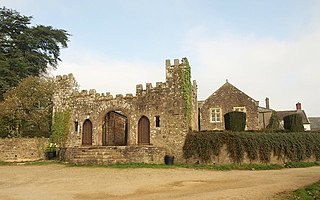| |||||
| Centuries: | |||||
|---|---|---|---|---|---|
| Decades: | |||||
| See also: | Other events of 1294 List of years in Ireland | ||||
Events from the year 1294 in Ireland.
| |||||
| Centuries: | |||||
|---|---|---|---|---|---|
| Decades: | |||||
| See also: | Other events of 1294 List of years in Ireland | ||||
Events from the year 1294 in Ireland.

Earl of Longford is a title that has been created twice in the Peerage of Ireland.

Baron Sandford is a title that has been created twice, both times in the Peerage of the United Kingdom. The first creation came in 1891 when Sir Francis Sandford, a civil servant who played an important role in the implementation of the Elementary Education Act 1870, was made Baron Sandford, of Sandford in the County of Salop. He was the son of Sir Daniel Sandford, politician and Greek scholar, the grandson of the Right Reverend Daniel Sandford, Bishop of Edinburgh, the brother of Daniel Sandford, Bishop of Tasmania, and the first cousin of the Right Reverend Charles Sandford, Bishop of Gibraltar. He was childless and the title became extinct on his death in 1893.

Ranelagh is an affluent residential area and urban village on the Southside of Dublin, Ireland in the postal district of D06.

The Dean of St Patrick's Cathedral is the senior cleric of the Protestant St Patrick's Cathedral, Dublin, elected by the chapter of the cathedral. The office was created in 1219 or 1220, by one of several charters granted to the cathedral by Archbishop Henry de Loundres between 1218 and 1220.
Fulk Basset was archbishop of Dublin. He was the elder brother of John de Sandford, who was also Archbishop of Dublin from 1284 to 1290.
John de Sandford was Archbishop of Dublin.
Sandford Park School is an independent, non-denominational, co-educational secondary school, located in Ranelagh, Dublin, Ireland. It was founded in 1922.
Baron Mount Sandford, of Castlerea in the County of Roscommon, was a title in the Peerage of Ireland. It was created on 31 July 1800 for Henry Sandford, with remainder in default of male issue of his own, to his brothers William Sandford and George Sandford, and the heirs male of their bodies. He had previously represented Roscommon Borough in the Irish House of Commons. He was succeeded according to the special remainder by his nephew, the second Baron. He was the son of William Sandford. Lord Mount Sandford was kicked to death during a brawl at Windsor on his way to the Ascot races in 1828. He was succeeded by his uncle, the third Baron. He had previously represented County Roscommon and Roscommon Borough in the Irish Parliament. The barony became extinct on his death on 25 September 1846. The Sandford family descended from Theophilus Sandford, who was granted lands at Castlerea in County Roscommon in reward for his services during the English Civil War. His grandson Robert Sandford was a member of the Irish Parliament for County Roscommon. The latter's eldest son, Henry Sandford, also represented this constituency in the Irish Parliament. Henry Sandford eldest son was the first Baron Mount Sandford.
Sandford is a village and civil parish in the Mid Devon district, within Devon, England. Sandford is part of the electoral ward named Sandford and Creedy. The ward population at the 2011 Census was 3,429.

Sir William Verner, 1st Baronet, KCH, was a British soldier who served in the Napoleonic wars, was wounded at the Battle of Waterloo and resigned as a colonel. He served as a politician, including 36 years as a Member of Parliament. Two of his sons were also members of Parliament. Verner was made Knight Commander of the Hanoverian Order and a Baronet, and was Grand Master of Armagh and Orange Order of Ireland.

Edward Michael Pakenham, 2nd Baron Longford was an Irish sailor and landowner.
The High Sheriff of Roscommon was the British Crown's judicial representative in County Roscommon, Ireland from 1575 until 1922, when the office was abolished in the new Free State and replaced by the office of Roscommon County Sheriff. The sheriff had judicial, electoral, ceremonial and administrative functions and executed High Court Writs. In 1908, an Order in Council made the Lord-Lieutenant the Sovereign's prime representative in a county and reduced the High Sheriff's precedence. However the sheriff retained his responsibilities for the preservation of law and order in the county. The usual procedure for appointing the sheriff from 1660 onwards was that three persons were nominated at the beginning of each year from the county and the Lord Lieutenant then appointed his choice as High Sheriff for the remainder of the year. Often the other nominees were appointed as under-sheriffs. Sometimes a sheriff did not fulfil his entire term through death or other event and another sheriff was then appointed for the remainder of the year. The dates given hereunder are the dates of appointment. All addresses are in County Roscommon unless stated otherwise.

The World's Champion is a 1922 American silent drama film produced by Famous Players-Lasky and distributed by Paramount Pictures. The movie is based on the play The Champion by Thomas Louden and A.E. Thomas that was produced on Broadway in 1921. The film was directed by Phil Rosen and starred Wallace Reid. This film survives in an incomplete form at the Library of Congress.
Sir Richard Sandford, 3rd Baronet was an English landowner and Whig politician who sat in the English House of Commons between 1695 and 1707, and in the British House of Commons from 1708 to 1723.
Henry Moore Sandford, 1st Baron Mount Sandford, was an Irish landowner and politician.
George Sandford, 3rd Baron Mount Sandford, was an Irish politician.
Events from the year 1830 in Scotland.
Events from the year 1827 in Scotland.

Dowrich is an historic estate in the parish of Sandford, on the River Creedy, three miles north-east of Crediton in Devon, England. Between the 12th century and 1717 it was the seat of the ancient gentry family of Dowrish which took its name from the estate where it had become established before the reign of King John (1199–1216), when it built a castle keep on the site. A 15th century gatehouse survives there today, next to the ancient mansion house.
The Sandford Award, previously the Sandford Award for Heritage Education, is a British and Irish award for education programmes at heritage sites. Its website describes it as "an independently judged, quality assured assessment of education programmes at heritage sites, museums, archives and collections across the British Isles".